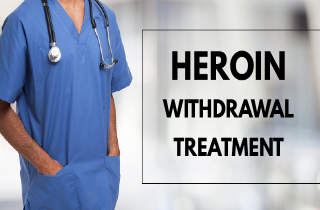ARTICLE OVERVIEW: Your body goes through a lot when it withdraws from heroin. Detox will impact you physically and mentally. In fact, heroin withdrawal symptoms treatment can be difficult, making it difficult to stay clean. This article reviews evidence-based treatments during withdrawal. Find suggestions for medications, protocols, and what to expect here.
TABLE OF CONTENTS
- What Is Withdrawal
- Common Symptoms
- Symptom Severity
- Protracted Symptoms
- Tapering
- Medications
- Detox At Home?
- Other Options
- Safety Considerations
- Facts and Statistics
- Signs You Need Professional Help
- Your Questions
If you are reading this and have hit rock bottom, or have a loved one ready to detox… we want to let you know you are not alone. Heroin detox can be managed medically. Read on for more, and we invite your questions in the comments section at the end.
What Is Withdrawal?
Heroin is a short-acting opioid. This means that it works very fast and leaves the body quickly. In fact, heroin enters to the brain rapidly and binds to opioid receptors on cells located in many areas, especially those involved in feelings of pain and pleasure and in controlling heart rate, sleeping, and breathing. But over time, the brain adapts to heroin.
Detox refer to the process of ridding the body of heroin. This takes time. The body needs to adapt chemically, and may take from 5 to 10 days in the person with a high dose dependency. Withdrawal is the medical term for “detox” and refers to a set of predictable symptoms that occur once you quit. Acute withdrawal symptoms resolve in the course of 2 to 4 weeks depending on treatments. Post-Acute Withdrawal Symptoms (PAWS) occur for several months or years, depending on drug use patterns.
Common Symptoms
Below is a list of withdrawal symptom that you can experience a few hours after quitting heroin. Some of these symptoms can persist for weeks to months later.
- Abdominal cramps.
- Aggression.
- Anxiety.
- Chills.
- Cold sweats.
- Constipation.
- Diarrea.
- Disconfort.
- Disturbed sleep.
- Depression.
- Drug cravings.
- Excessive yawning.
- Fever.
- Insomnia.
- Mydriasis (dilatation of the pupil).
- Nausea.
- Pain and cramps the body.
- Priapism (condition in which a penis remains erect for hours in the absence of stimulation or after stimulation has ended).
- Restlessness.
- Tearing.
- Vomiting.
No two cases of withdrawal will be the same. The severity of withdrawal depends on the level of use and the level of physical dependency for each person. So, the more you used or the longer you’ve been on heroin…the more intense the withdrawal. However, medications can help!
Symptom Severity
Medical detox staff supervise heroin detox by assessing symptoms 1-2 a day. They use a scale called, COWS, or Clinical Opioid Withdrawal Scale . This is a clinical assessment conducted by a health care professional that measures opioid withdrawal symptoms such as resting pulse rate, sweating, pupil size, gastrointestinal issues, bone and joint aches, tremors and anxiety. [1]
During each assessment, your personal scores ranges from 0 to 36. The higher the number, the more severe the withdrawal symptoms are to a person. The assessment helps guide the treatment on an individual basis so that medicines and treatment can be provided, as needed.
Protracted Symptoms
Sometimes, symptoms of withdrawal extend way beyond the first week of detox. When you decide to stop taking heroin, the body is re-wiring its chemistry to adapt to functioning without Heroin. For heavy or long time user, it can take months to years to recover from some of the damage heroin has caused.
For example, heroin use can permanently damage the liver or kidneys, as well as affect the brain. Chronic medical issues may also be masked by heroin use. So, what are the most common protracted symptoms?
Common protracted withdrawal symptoms include:
- The inability to feel pleasure, anhedonia.
- Increased perception of pain.
- Mood disorders like anxiety or depression.
- Reduced interest in sex.
- Sleeping problems.
First, heroin effects serotonin levels in the brain and your ability to feel pleasure. Over time, heroin becomes the only way you experience pleasure…and even then, heroin stops working over time. More on the way the brain works in this NIDA video on the brain. [2]
Second, one long-term effect of withdrawal from heroin is a hard time regulating your emotions and mood. This psycho-emotional effect can make relapse likely because it drives use, regardless of the negative impact heroin may have your health.
In other cases, people use heroin to regulate pain. During withdrawal, pain can resurface, making physical effects of withdrawal painful. After initial detox, the perception of pain can be more sensitive.
What’s important to know is that these protracted symptoms occur because of brain changes…and will resolve over time. If you experience any of the above, report them to your physician. It’s possible that additional diagnoses, treatments, and lifestyle changes can help.
Tapering
Tapering is a medical term that refers to the act of lowering the drug dosage over time. The idea of a heroin taper is minimize adverse effects during discontinuation of the drug. When it comes to heroin, tapering protocols are not medically advised. Instead, withdrawal can be managed using other medications we will mention next… always under medical observation.
Medications
Several medications exist that can help treat heroin withdrawal symptoms. Typical medications prescribed to treat withdrawal symptoms include:
- Buprenorphine
- Clonidine
- Methadone
- Naloxone
Buprenorphine: This synthetic opioid actually blocks the effects of heroin and occupies the opioid receptors in the brain. Use of buprenorphine helps to ease drug cravings and minimize effects of withdrawal symptoms. Buprenorphine is less habit forming than methadone as it helps flush opiate receptors and restores chemical balance to the central nervous system.
Clonidine: This detox medicine supports acute withdrawal symptoms such as nausea, anxiety, and high blood pressure.
Methadone: This is a medicine used to replace heroin as a substitute therapy for it is a longer acting medication. It has been the most common treatment, which is monitored and regulated by a clinician.
Naloxone: A drug used to counter the effects of opiate use that is an opioid agonist which cancels out the effects of heroin if you use it. In other words, if you’re on naloxone and use…you don’t get high.
According to this 2007 article published in the medical journal, Dialogues in Clinical Neuroscience, the most effective withdrawal method for opioid dependence is substituting and tapering methadone or buprenorphine. [3]
Still, medicine alone cannot help you quit heroin for good. Medications are designed to be used at the same time as counseling. In fact, behavioral therapies in either individual or group settings are effective in helping people stop heroin use. However, treatment plans should be individualized to meet your needs.
Detox At Home
So, can you detox from heroin at home?
Yes, it can be done, but, with a higher risk of relapse. Plus, you may feel worse when detoxing from home than when you started…because you’ve had to go through hell. If you want to quit heroin for good, the best way to treat withdrawal is under medical supervision. You can find a detox clinic or rehab facility to assist you.
Why consider a medical detox? This way, you have a decreased risk of relapse because symptoms are treated as they occur. Plus, you can benefit from the emotional support. Under medical supervision, your physical and psychological symptoms are being discussed and addressed by a team of staff. In effect, you can treat withdrawal and addiction issues simultaneously.
Other Options
Are there other options for heroin withdrawal and treatment?
On November 15 of 2017, FDA permitted the marketing of the first device for use in helping to reduce the symptoms of opioid withdrawal; The NSS-2 Bridge device is a small electrical nerve stimulator placed behind the person’s ear. It contains a battery-powered chip that emits electrical pulses to stimulate branches of certain cranial nerves. Such stimulations may provide relief from opioid withdrawal symptoms. [4]
Safety During Withdrawal
Before starting the withdrawal treatment make sure to clearly state if you suffer any of the following, because of the elevated risk of exacerbate them or generate any drug interaction:
- Acute alcohol dependence.
- Diabetes.
- Head injury.
- Respiratory deficiency.
- Severe hepatic impairment.
- Treatment with monoamine oxidase inhibitors (first type of antidepressant developed).
- Ulcerating colitis or Crohn’s disease (inflammatory bowel diseases).
- Urethral obstruction.
After detox, be advised that they are at increased risk of overdose due to reduced tolerance. Therefore, if you should use opioids for any reason, take a smaller amount than usual to reduce the risk of overdose.
Signs of a Drug Problem
If you are using heroin, you have a drug problem.
Heroin is addictive and harmful no matter if it is injected, smoked, or snorted. People who get addicted to heroin need to keep taking it to feel normal and may take more and more of it to get the same high.
Who Use Heroin?
There is no typical heroin user. Still, some general use patterns in the U.S. reveal that a greater number of heroin users are:
- 18 to 25 year olds.
- Males.
- Non-Hispanic whites.
- People living in a large metropolitan area.
- People who are addicted to cocaine, marijuana, alcohol, or prescription painkillers.
- People without insurance or enrolled in Medicaid.
The CDC reports that heroin use has increased across the U.S. among men and women, most age groups, and all income levels. Some of the greatest increases occurred in demographic groups with historically low rates of Heroin use: women, the privately insured, and people with higher incomes [5]:
- Heroin use more than doubled among young adults ages 18–25 in the past decade.
- More than 9 in 10 people who used Heroin also used at least one other drug.
- 45% of people who used Heroin were also addicted to prescription opioid painkillers.
According with the National Survey on Drug Use and Health NSDUH, in 2016, an estimated 948,000 people aged 12 or older used Heroin. The estimate of heroin use in 2016 (0.4 percent) was higher than the estimates for all years between 2002 and 2013, but it was similar to the estimates in 2014 and 2015. [6]
- 0.1 percent of adolescents were Heroin users. The percentage of adolescents in 2016 who were past year Heroin users was similar to or slightly lower than the percentages in 2002 through 2015.
- Among young adults aged 18 to 25 in 2016, 0.7 percent were Heroin users. This percentage was similar to the percentages between 2009 and 2015 (ranging from 0.5 to 0.8 percent), but this percentage in 2016 was higher than the percentages in most years from 2002 through 2008 (ranging from 0.3 to 0.5 percent).
- In 2016, 0.3 percent of adults aged 26 or older were Heroin users. This percentage represents was similar to the percentages in 2014 and 2015, but it was higher than the percentages in all years from 2002 to 2013.
As you see, you are not the only one with this problem…
Your Questions
Still have questions about withdrawal? Would you like to know more about what to expect? Are you scared about the process? You are not alone. We are here to help. Please ask any questions you may have and we will get back to you personally and promptly.











Related Posts